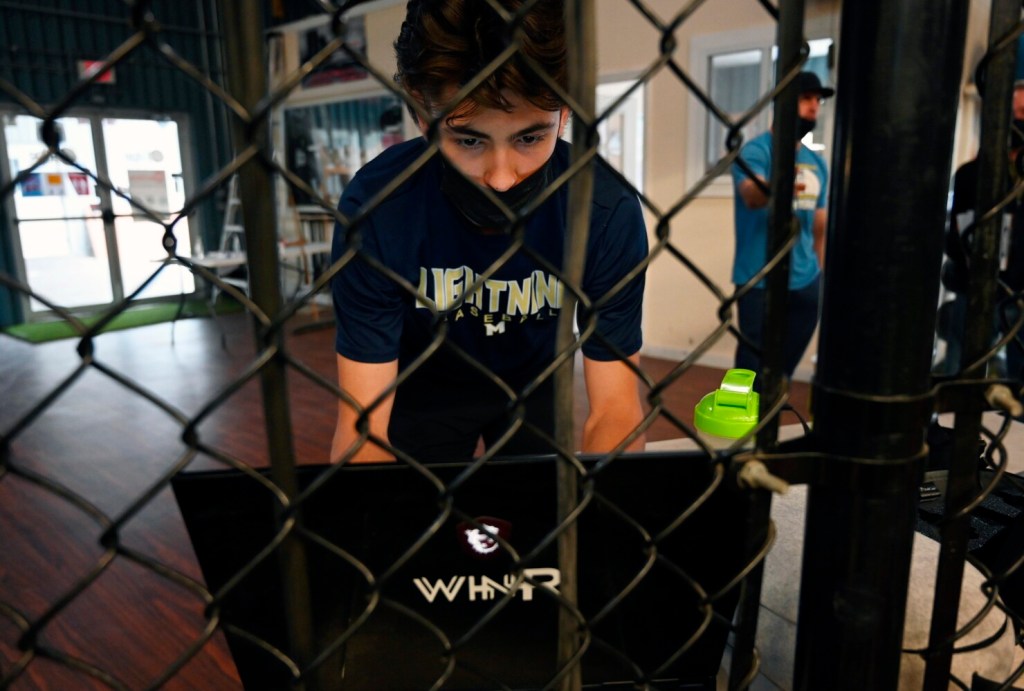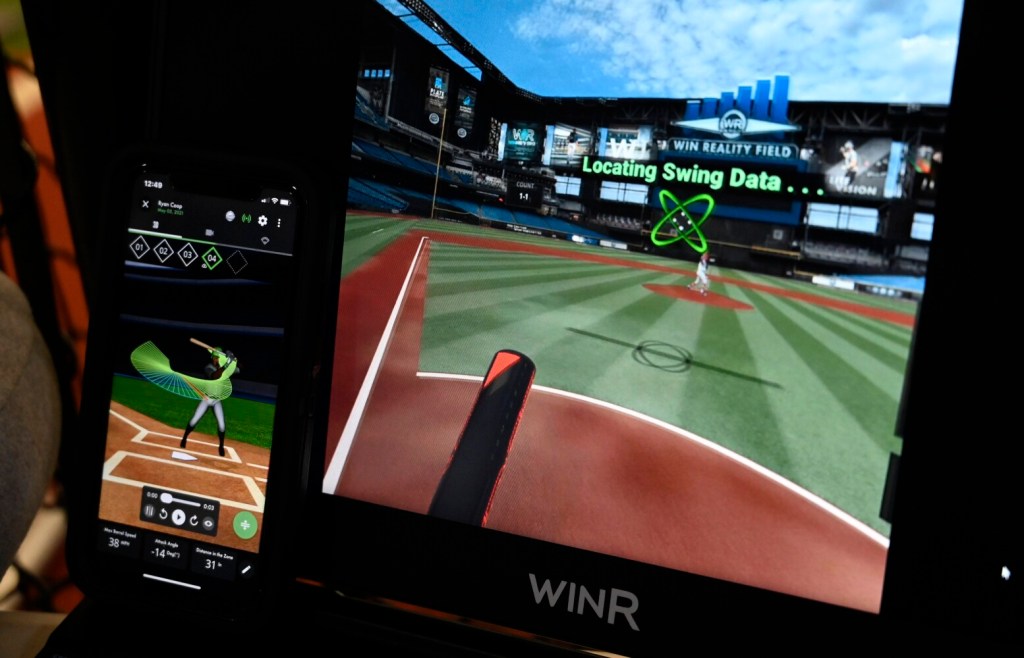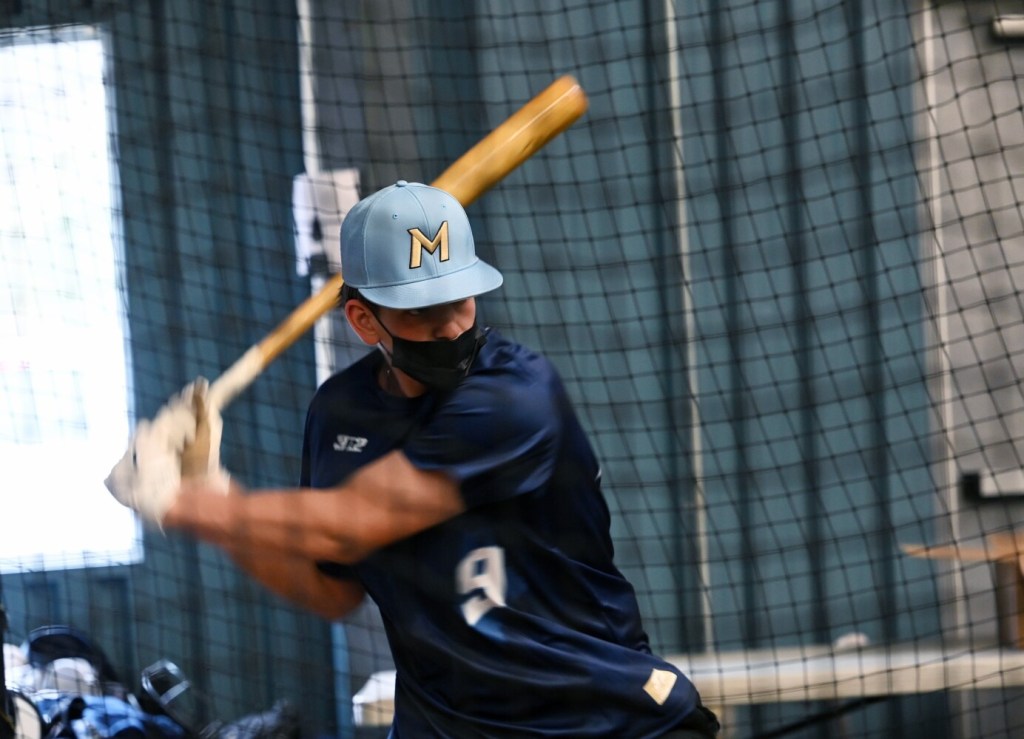Nic Frink is only 16 years old but he’s already seen big changes in the way technology is used in baseball.
“I’ve been coming here since I was 10 or 11 years old,” Frink said. “When I first started there was nothing like this. It was a whole different program.”
“Here” is The Edge Academy, a baseball and softball training facility in Portland. Frink, a junior catcher and pitcher at Scarborough High, was speaking near one of the indoor hitting cages, pointing to the three computer monitors displaying simulations and data reports from highly sensitive motion detection devices and a pair of virtual reality goggles.
Specialized technology has become an integral part of baseball training, and not just at the professional level. Over the past few years tech tools have increasingly reached the youth level as a means of evaluating and improving player mechanics, adding a fun and competitive element to training, and enhancing a recruiting portfolio with verifiable data for college coaches.
The high-speed motion detectors are focused on the two core elements of the game – how a pitcher throws a ball and how a batter swings and makes contact with a pitch.
The tools make it easier for players like Frink to detect flaws and then gauge how well a needed change is working.
Earlier this year, Frink felt his powerful swing needed an adjustment. So he strapped on something called the K-Vest, a harness with multiple body sensors connected to a software program that creates a detailed 3-D image of how a player moves their body during a swing.
“I learned I was firing my upper body before my hips which was causing me to roll over the top of the ball and ground it,” Frink said. “Maybe a really high-level coach might have seen that, but for just a normal person to look at a swing, you wouldn’t have been able to see it.”
Over the past few years The Edge Academy has invested over $30,000 in physical tools and spent thousands more annually on subscription costs for proprietary software. The Edge Academy, and its club baseball program Maine Lightning, has helped guide 25 players to NCAA Division I programs since 2015. Five of its current high school juniors have verbally committed to Division I programs.

Ryan Copp of The Edge Academy in Portland looks over a computer to monitor a player’s biomechanics as the player wears a K-Vest while swinging at pitches. Shawn Patrick Ouellette/Staff Photographer Buy this Photo
Ryan Copp, the director of baseball programs at The Edge Academy, said the tech tools are primarily used to help players learn about and improve their skills. It starts with an in-depth evaluation of a player’s body movement and strength along with their current swing or throwing ability.
Then Copp or one of the other trainers designs a multi-week program (usually 10 weeks for the older, elite players) to target specific areas of improvement. During the process, the technology provides rapid-fire assessment. The cost for an immersive membership ranges from $425 for three months to $1,200 for a year-long membership.
When the coronavirus pandemic kept college coaches from making in-person recruiting visits during the past year, tech data became essential supporting evidence of a player’s abilities and potential.
“Right now, I feel like the game is all about the numbers,” said Ryan Kolben, a junior catcher at Greely who has committed to an athletic scholarship at the University of Massachusetts. “It’s like exit velocity, distance, all that. So I think it’s kind of a baseline for the coaches to look at. To be able to say, I hit a ball 95 mph, it turns an eye … and then it makes them say, ‘Hey, let’s watch this kid play.’ I think that’s important.”
HIGH TECH HAS COME A LONG WAY
Michigan State coach Danny Litwhiler is credited with being the first person to use a police radar gun to determine pitch speed. He brought a police car on the field – the radar gun had to be plugged into the cigarette lighter – in 1974. A year later, the JUGS Co. came out with a baseball specific radar gun. Baltimore Orioles manager Earl Weaver was an early convert, and soon it became commonplace to see a scout pointing a radar device at the pitcher.
Little changed for nearly 40 years. The on-screen graphic showing the strike zone for television viewers was introduced by ESPN in 2001 and pitch-speed scoreboards became common in professional ballparks. But those advancements were primarily for fan entertainment.
“When I was coaching at Southern New Hampshire (2009-11) none of this was around,” Copp said. “It’s really just been the past five years where this has exploded.”
The Edge Academy has five primary tools in its tech arsenal:
• HitTrax, a multi-camera device set up in a batting cage that is used to measure a variety of hitting metrics, including exit velocity of the ball off the bat, projected distance a ball would travel in the air, and percentage of solid contact during a hitting session. The software-generated results appear almost instantly on a simulated ball field displayed on a monitor. The initial cost was $20,000.
• Rapsodo for pitching: Similar to HitTrax, Rapsodo creates a simulated image of a pitched ball with measurements for speed, spin rate, vertical and horizontal break, relationship to the strike zone and the pitcher’s release point and arm angle. Costs $4,000.
• K-Vest, a wearable motion sensor that measures kinetic movement during a swing and provides detailed information related to torque, speed of motion, and how well the body is synchronized to maximize power and efficiency. Costs $6,000.
• Diamond Kinetics: A modestly priced ($100) device attached to a bat. It is usually paired with the K-Vest to get similar information about bat speed and the plane of a player’s swing.

Zach Johnston of Cumberland adjusts virtual reality goggles during training at The Edge Academy. Shawn Patrick Ouellette/Staff Photographer Buy this Photo
• Virtual Reality goggles: The newest developmental tool, coming on the retail market last summer. They are primarily used for hitters to practice pitch recognition and increase their strike zone awareness against virtual pitchers. The upfront cost is $500-1,000 for the goggles and to have a computer installed with the software. The subscription for the software is $200 per month.
Other clubs in Maine also are joining the tech movement. Hitter’s Count in Saco, home to the Southern Maine River Rats, has HitTrax. Sluggers in Brewer has both HitTrax and Rapsodo.
The University of Maine uses Rapsodo devices for both hitting and pitching, head coach Nick Derba said. He would like to find a way to fund virtual reality goggles for his program.
“I think that technology has a chance of doing some really awesome stuff,” Derba said. “To be able to take swings and see pitches and different pitchers, that’s a real future I think. Hitters get better when they see pitches.”
‘IT BRINGS YOU UP TO ANOTHER LEVEL’
Greely High junior Zach Johnston now can get an array of information with every pitch he throws at The Edge Academy. In addition to speed, Johnston can easily see how rapidly a pitched ball rotates (spin rate), its direction of rotation (spin angle), how much it moves both vertically and horizontally, and its relation to the strike zone.
“It’s all just super helpful because it helps you get those good numbers that you’re striving for,” said Johnson, a tall, lean left-hander who has verbally committed to pitch at the University of Maryland. “Getting all that extra information just based off that little machine has helped so much with my game.”
Johnson said the advantage of having immediate data is it verifies success. That’s especially important when a pitcher is making changes to their motion or grip in an effort to improve.
“You see those changes and you know you’re doing something right, which in turn makes you a better pitcher,” he said.
Cody Bowker of Bowdoinham, a junior at Thornton Academy, believes all of the tools have made him a better player. Bowker is committed to Georgetown University as a pitcher and outfielder.

Cody Bowker of Thornton Academy takes pitches while training at The Edge Academy last week. Bowker was being monitored with HitTrax, which monitors pitch location, exit speed and other factors. Shawn Patrick Ouellette/Staff Photographer Buy this Photo
“The next level is the analytic stuff, seeing your hips, your chest, your shoulders, your arms, your legs all come together and you can’t really see that or feel that just hitting off the tee,” Bowker said. “It brings you up to another level and then you learn to recognize stuff because of the technology.”
The technology also increases the fun level and provides immediate positive reinforcement.
“It’s a lot more fun than hitting off a tee 200 times,” said Frink, the Scarborough High junior, who is being recruited by several Division I programs, including West Virginia, Seton Hall and Rutgers. “You’re able to see how fast you’re hitting the ball and where you hit it. And you’re able to hit on a (virtual) major league field.
“For myself, when I see myself improve and beat my personal best, it makes me want to top that personal best.”
But high-tech gadgets are not the be-all, end-all.
Copp said it’s essential that coaches have the ability to relate to their players, while understanding every player has different strengths and weaknesses that require individualized training programs.
Bowker reminds himself to not develop bad habits while chasing “a number.”
“I want to hit the ball 105, 110 miles an hour and I’m in the cage taking huge hacks,” Bowker said. “Yeah, I might get one 105 but the rest are maybe pop-ups and swings and misses. I’ve had to learn how to use it to my advantage and then kind of put it down when I don’t need it.”
And, ultimately, technology only helps a player prepare.
“You can get as much technology as you want but there’s nothing better than playing an actual game. That’s the most beneficial to anybody,” Bowker said.
Technology might not cinch a college scholarship but it does help a player get noticed, said Derba, the UMaine coach.
“The value for me is really for the initial, ‘Hey, let’s go see somebody,'” he said. “I’ve seen a lot of really good batting practice hitters and in a game they can’t catch up to an 85 mile an hour fastball, or a pitcher with a really great spin rate but he can’t throw strikes in a game.”
Send questions/comments to the editors.











